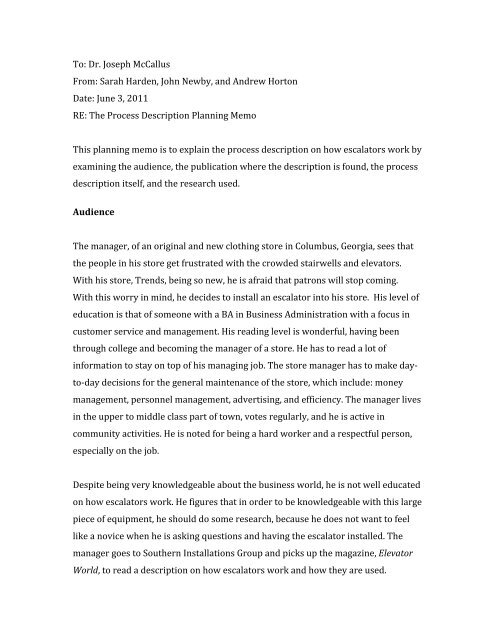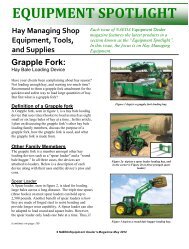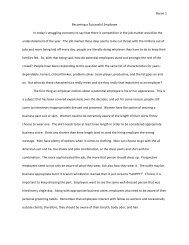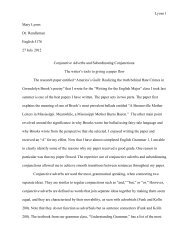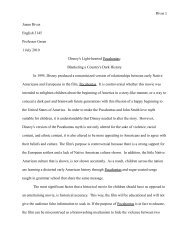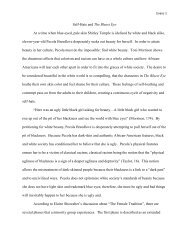Escalator Planning Memo - studentwebs.ColumbusState.edu
Escalator Planning Memo - studentwebs.ColumbusState.edu
Escalator Planning Memo - studentwebs.ColumbusState.edu
- No tags were found...
You also want an ePaper? Increase the reach of your titles
YUMPU automatically turns print PDFs into web optimized ePapers that Google loves.
To: Dr. Joseph McCallus From: Sarah Harden, John Newby, and Andrew Horton Date: June 3, 2011 RE: The Process Description <strong>Planning</strong> <strong>Memo</strong> This planning memo is to explain the process description on how escalators work by examining the audience, the publication where the description is found, the process description itself, and the research used. Audience The manager, of an original and new clothing store in Columbus, Georgia, sees that the people in his store get frustrated with the crowded stairwells and elevators. With his store, Trends, being so new, he is afraid that patrons will stop coming. With this worry in mind, he decides to install an escalator into his store. His level of <strong>edu</strong>cation is that of someone with a BA in Business Administration with a focus in customer service and management. His reading level is wonderful, having been through college and becoming the manager of a store. He has to read a lot of information to stay on top of his managing job. The store manager has to make day-to-‐day decisions for the general maintenance of the store, which include: money management, personnel management, advertising, and efficiency. The manager lives in the upper to middle class part of town, votes regularly, and he is active in community activities. He is noted for being a hard worker and a respectful person, especially on the job. Despite being very knowledgeable about the business world, he is not well <strong>edu</strong>cated on how escalators work. He figures that in order to be knowledgeable with this large piece of equipment, he should do some research, because he does not want to feel like a novice when he is asking questions and having the escalator installed. The manager goes to Southern Installations Group and picks up the magazine, Elevator World, to read a description on how escalators work and how they are used.
2 Southern Installations Group is a company that specializes in installing and removing elevators and escalators. Publication The magazine, Elevator World, is a magazine specifically designed to inform the reader about all major aspects of elevators and escalators. It is published biannually. The articles cover topics such as how to select the right type of escalator, how elevators and escalators are installed and proper maintenance. First published in 2001, this magazine has been used by many new and potential elevator and/or escalator purchasers to learn about the intricacies of their installation and use. The Process Description SUPRATEXT The major parts of the process description include: “The Introduction,” “The process and the Parts of an <strong>Escalator</strong>,” and the “Summary and Conclusion.” The main title at the beginning of the description is “How <strong>Escalator</strong>s Work,” letting the reader know that they are about to read the description of how an escalator works. The entire document is in a two-‐column format with the left column designated for the paragraph titles and the right column designated for the main information. Introduction The introduction includes the main “Definition,” the “Purpose and Theory,” a “Brief History,” and the “Stages and Parts.” The main definition of the “Definition” section includes the term (escalator), the genus (type of stairs), and the differentia (that moves automatically up and down in various public venues). This genus was chosen because it can be broken down into two types: stairs that move and stairs that stay immobile.
3 The “Purpose and Theory” section describes the main reasons of how and why the escalator was invented. The reasoning behind the “Purpose and Theory” section is to explain that an escalator is used for more than just travelling up and down to different floors. It is also used for crowd control to keep the stairwells unclogged. The “Brief History” section was included to show that escalators have been useful for mankind for over one hundred years. They are handy inventions that revolutionized the way people move in airports, department stores, and other large public venues. This section is important for the reader, because it lets them know that an escalator is more than just a moving staircase. The “Stages and Parts” section explains the four stages of how an escalator works in an overview and defines all of the different escalator parts mentioned in the stages section later in the process description. The whole point of the description in the magazine, Elevator World, is to let the reader know how an escalator works. There is also a quick, two-‐sentence description for an overview of what is to come in the main stages section of the description. The definitions in “The Parts” section explain in more focused detail, the function of each part mentioned in the stages. Stages The stages start at the power source and go all the way up the escalator to the steps and the handrails. These stages were chosen because they are sequential; each step initiates the next step. Once you turn on the engine (stage one), the drive gear and the bull gear turn the step chain (stage two). The steps are attached to the step chain and are pulled to a turnaround to complete another rotation cycle (stage three). Stage four describes how the steps flatten out and expand when on flat ground and when on the vertical slant of the escalator. There is also a description of how the handrails function, since they are part of the escalator as a whole, even though they are not in the main underground driving system in the truss.
4 The “The Parts” section was decided upon so that the description would not get too jumbled and cluttered with numerous parenthetical definitions. The “The Parts” section works as a glossary, defining each term that is mentioned in the stages section of the description. The parts in this section include: the top and bottom of the escalator, the drive gear, the drive unit, the drive chain, the bull gear, the step chain, the turnaround gear, the truss, the roller guide, the handrails, and the handrail roller. Summary and Conclusion This section was included to review the main stages mentioned earlier in the description. This section ties everything back together and concludes the description very nicely. There is also an analogy in this section to give the reader a mental image they are familiar with to help them relate and compare everything they just read. The analogy is the first sentence of this section and is as follows: “An escalator is easily compared to a checkout counter conveyor belt at the grocery store. It is in constant rotation due to an engine and a couple of gears, wheels, and chains.” The “Summary and Conclusion” section brings the entire description home by mentioning a history fact, “the invention of the escalator in the late 1800’s…,” from the very beginning of the document. EXTRATEXT The first image is Figure 1 at the end of the process description and it depicts a cross section of an escalator. The image has arrows which label the parts mentioned in “The Process” section of the description. This picture is used to show the reader what an escalator looks like and where certain parts are. The second image, Figure 2, also at the end of the process description, is a flow chart. This chart is used to show the flow of operations for an escalator. Each square has a brief note that tells the reader what happens at that stage of the process. The first step is where the drive unit (engine) turns the drive chain. Next, the drive chain
5 turns the drive gear and the bull gear (which is attached to the drive gear). Lastly, the bull gear turns the chain of steps, which travels up or down the escalator and then loops back around, completing the cycle. INTERTEXT All paragraphs were constructed to inform the reader. The “Introduction” includes the sections of: “Definition,” “Purpose and Theory,” “Brief History,” and “Stages and Parts.” The “Definition” section includes the definition of an escalator and the fact that escalators are used in many public venues. The “Purpose and Theory” section says that an escalator cuts down on pedestrian congestion in stairwells and that they are a good resource for the elderly and the sick. The “Brief History” includes the facts of when the escalator was first invented (1897) and when it was first patented for commercial use (1899). The “Stages and Parts” section includes the main points of the stages, a brief description of the entire process, and the parts that are defined. The “Process and the Parts of an <strong>Escalator</strong>” section includes the four stages, a description of how the handrail works, and the list of terms and their definitions. The “First Stage” paragraph explains that the engine in the drive unit powers the entire escalator. The “Second Stage” paragraph explains how the drive gear turns the bull gear and the step chain. The “Third Stage” paragraph explains that the steps are attached to the step chain and that they travel to the turnaround at the bottom of the escalator. The “Fourth Stage” paragraph explains how the steps travel through the system to complete their rotation. “The Handrail” paragraph explains that the handrails rotate with the help of the handrail rollers. The last paragraph of the “Process and the Parts of an <strong>Escalator</strong>” section is the definitions of all the terms used in the stages.
6 The next paragraph is in the “Summary and Conclusion” section. This paragraph reiterates the four stages, gives an analogy, and pulls the entire document together with a recapitulation of the “Brief History” section from the beginning. The paragraphs are easy to read. The audience is made up of people who are experts in their managerial field, but when it comes to escalators and how they work, they need simple descriptions in each paragraph. We use plenty of white space between paragraphs to give the reader a chance to reflect on what was just read. The sentences are easy to read and understand. We use descriptive sentences like, “the drive gear is attached to the bull gear” (second stage) to aid the reader in understanding and putting together mental pictures in their heads. We also use simple sentences like, “The steps and the step chain stay on their track with the help of the roller guide” (fourth stage) to help the reader recognize the events that take place. We use single spacing between lines to give the document a professional and clean look. INTRATEXT The font on the process description is Times New Roman for both the text and the main section titles for a tidy, professional look. The main paragraph font is 12 point and the main section titles are in bolded 12 point font. The entire description’s title (How <strong>Escalator</strong>s Run) is bolded 18 point font. Everything was meant to look uniform and clean. The word choice is simple to accommodate and satisfy the audience. People who read Elevator World, the magazine, are people who need to know how elevators and escalators work, so the word choice has to be simple. All technical terms in the four stages are explained in the “The Parts” section for clarification. For example, “The main parts of an escalator include…,” shows thatsimple word choice is used to be direct and to the point.
7 Research Works Cited "Virtual <strong>Escalator</strong>." Precision <strong>Escalator</strong> Products Inc.. Precision <strong>Escalator</strong>, 2008. Web. 30 May 2011. . We used the virtual escalator from this website as figure 1 to learn about the different parts and to have a model for the different stages. "Elevators and <strong>Escalator</strong>s." Mitsubishi Electric. Mitsubishi Electric, 2008. Web. 1 Jun 2011. . We used information from this website for the “Brief History” section of the process description. "<strong>Escalator</strong>." The Great Idea Finder. Idea Finder, 1997-‐2007. Web. 30 May 2011. . We used information from this website for the “Brief History” section of the process description. "History of the <strong>Escalator</strong>." About.com Inventors. About, 2011. Web. 30 May 2011. . We used information from this website for the “Brief History” section of the process description. "Gliffy Flow Chart." Gliffy. Gliffy, 2011. Web. 2 Jun 2011. . We used this website to find a template for the flow chart and for figure 2.
8 Thank you, Dr. McCallus. Sincerely, Sarah Harden John Newby Andrew Horton


